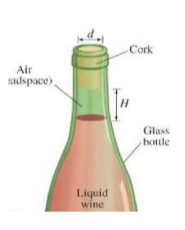Wine bottles are never completely filled. A small volume of air is left in the glass bottle as shown in the figure (take it as a cylinder). The diameter in this space is d = 18.55mm. The distance between the surface of the liquid and the bottom of the cork generally has a distance of H = 1.5 cm for 750mL bottles filled at 20 ° C (????? = 1.2???3, molar mass air 28.97kg / mol). Due to the alcohol in the wine, the coefficient of thermal expansion of volume (? = 3?) is about twice that of water. It neglects the expansion of the glass • How many moles of air are there in the space between the surface of the wine and the cork • Which What is the pressure in the air when the wine was bottled? • Estimate H if the bottle is kept at 10 ° C
Wine bottles are never completely filled. A small volume of air is left in the glass bottle as shown in the figure (take it as a cylinder). The diameter in this space is d = 18.55mm. The distance between the surface of the liquid and the bottom of the cork generally has a distance of H = 1.5 cm for 750mL bottles filled at 20 ° C (????? = 1.2???3, molar mass air 28.97kg / mol). Due to the alcohol in the wine, the coefficient of thermal expansion of volume (? = 3?) is about twice that of water. It neglects the expansion of the glass • How many moles of air are there in the space between the surface of the wine and the cork • Which What is the pressure in the air when the wine was bottled? • Estimate H if the bottle is kept at 10 ° C

Trending now
This is a popular solution!
Step by step
Solved in 2 steps with 2 images
